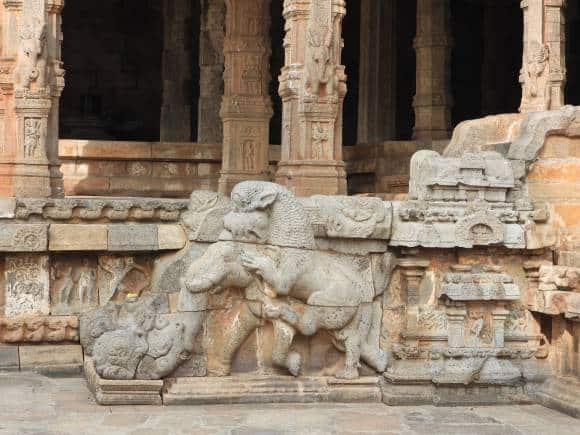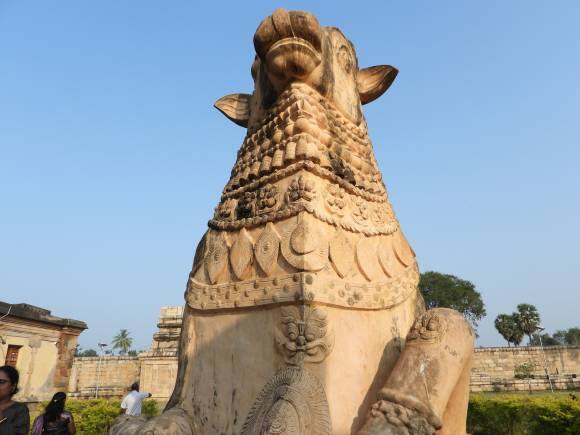



The Chola empire has been a memory from my history textbook in school and as the longest ruling dynasty, their history is older than one would imagine. After the release of the Mani Ratnam-directed Ponniyin Selvan I, the film that raked in ₹500 crore to become the highest grosser of Kollywood in 2022, the Cholas seem to have rekindled their former glory. The Tamil Nadu Tourism Department is fuelling this interest with specifically designed Ponniyin Selvan tours as well.
On a recent trip to Kumbakonam, Harish Venkat, general manager, Mantra Koodam — CGH Earth explained, "the story of Cholas starts goes back over 6,000 years and it starts with Karikala Cholan who built the Kallanai, an ancient dam in 150 AD. There is also Musukunda Chakravarthy who was a king who ruled the Chola kingdom from Karur and Kochengat Cholan or Śengaṇān who finds mention in Sangam poetry. Most of the temples around Kumbakonam have been done by Sembian Mahadevi, a Chola queen from the 10th century.” While there are temples galore, three of them stand out for their inscription in UNESCO and the grandeur rightly gives them the title of being the Great Living Chola Temples.
Brihadisvara Temple, Thanjavur Paintings in the ceiling at Brihadisvara, or Big Temple, Thanjavur. (Photo: Bindu Gopal Rao)
Paintings in the ceiling at Brihadisvara, or Big Temple, Thanjavur. (Photo: Bindu Gopal Rao)Often dubbed "The Big Temple", the Brihadisvara temple is also called the Thanjai Periya Kovil, and Rajarajeswaram. Dedicated to Lord Shiva, this temple represents a cosmic structure called the Dakshina Meru or Meru of south and is built in Hindu Dravidian style of architecture. Rajaraja is credited with building this temple between 1003 and 1010 CE. The temple complex like its name is "big" in every sense of the word and comprises numerous sub temples and mini complexes that has shrines dedicated to Dakshinamurti, Chandeshvara, Varahi, Nandi, Parvati, Kartikeya, Ganesha, Sabhapati and the temple spire is said to be among the tallest in South India. Incidentally the vimana or tower above the sanctum sanctorum does not cast a shadow. Made with granite, there are some excellent Chola frescoes on the walls depicting Lord Shiva in the courtyard that runs along the boundary, sadly many of these have faded significantly. Do make sure you visit the Nandi Shrine and look at the ceiling for some of the magnificent artwork. Smaller shrines dedicated to Ganesha, Amman, Kuruvurar can be seen around the main structure. “The architecture of the temple has been designed in a way that makes it earthquake resistant as the basement of the temple is filled with sand and the entire structure is built on a moving raft that can absorb frictions. This has also inspired the rocking Kumbakonam dolls as well as the Tanjore dancing doll,” adds Venkat. There is much to see here so keep aside at least two hours to explore.
Airavatesvara Temple, Darasuram Airavatesvara Temple, Darasuram. (Photo: Bindu Gopal Rao)
Airavatesvara Temple, Darasuram. (Photo: Bindu Gopal Rao)The Airavatesvara temple at Darasuram built by Rajaraja II in the 12th century is a fine example of the architecture and sculpture of the period. The stone structure has the sanctum sanctorum, mandap and pradakshina path. The sanctum here does not have a circumambulatory path. The temple is filled with detailed carvings in stone on the façade and pillars. When you are here, check out the front mandapa that has an inscription with the words Rajagambhiran tirumandapam which means chariot with wheels, which is how this place has been designed.
 The chariot at Airavatesvara temple at Darasuram. (Photo: Bindu Gopal Rao)
The chariot at Airavatesvara temple at Darasuram. (Photo: Bindu Gopal Rao)This hall has intricately carved steps that are called the "singing steps" as they are believed to be able to produce music. The temple has an interesting legend associated with Lord Indra’s vehicle, the white elephant, Airavata who was cursed by Sage Durvasa when he trampled a garland given by the sage. Durvasa, known for his short temper cursed the elephant who developed severe skin discolouration who went to Lord Shiva for help. It was Shiva who suggested that Airavata take a dip in the sacred waters in a healing pond at Darasuram after which the blemishes disappeared and then Rajaraja II built a temple around this pond. The story is carved on stone within the temple premises too. The main deity here is Shiva and a temple dedicated to his consort Periya Nayaki Amman temple is adjacent to the main shrine. There are shrines dedicated to other Gods and Goddesses are also seen inside the temple.
Brihadisvara temple, Gangaikonda Cholapuram Brihadisvara temple, Gangaikonda Cholapuram. (Photo: Bindu Gopal Rao)
Brihadisvara temple, Gangaikonda Cholapuram. (Photo: Bindu Gopal Rao)Built in the 11th century at Jayankondam, Ariyalur district by Rajendra I, to commemorate his conquest of the Gangetic plains, the temple is called Gangaikonda, meaning conquest of the Ganges. Dedicated to Lord Shiva temple called Gangaikondacholisvarar here, he made this town his capital which continued for over 250 years. As his father had built the massive Brihadeshwara temple in Thanjavur, he decided to build a smaller temple but ensured it has the largest Shiva Linga.
 Nandi in Brihadisvara temple, Gangaikonda Cholapuram. (Photo: Bindu Gopal Rao)
Nandi in Brihadisvara temple, Gangaikonda Cholapuram. (Photo: Bindu Gopal Rao)At the entrance of the temple is a gigantic Nandi statue said to deflect the morning light from entering the inner shrine. The design of the complex has much attention to detail and form as the Gopura, Nandi, Mahamandapa, Arthamandapa and Garbhagraha are centrally aligned in linear succession from east to west. The massive temple structure is elevated and stands at a height of about 55m. When here check out the sub-shrines of Chandesa, Amman and Simhakeni as well as the beautiful figurines of a dancing Ganesha, Lakshmi, Chandesanugrahamurti and Sarasvati that are masterpieces of Chola art.
Discover the latest Business News, Sensex, and Nifty updates. Obtain Personal Finance insights, tax queries, and expert opinions on Moneycontrol or download the Moneycontrol App to stay updated!
Find the best of Al News in one place, specially curated for you every weekend.
Stay on top of the latest tech trends and biggest startup news.